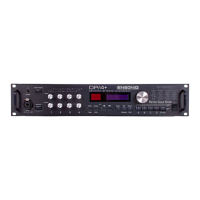Section 2 - Getting Started
• Parallel routing
means
the same
input
signal is routed separately to
inputs
of
both
units,
and
then
their
outputs
are mixed together.
This
is
parallel signal routing between two units:
Input
Output
Signal
Signal
Unit
In
this example,
if
the
first
unit
is a chorus,
and
the second a reverb,
you
would
hear
the
chorused
sound
and
a
sound
with
reverb,
but
the chorused
sound
would
not have reverb
on
it,
and
the
sound
coming
out
of
the
reverb
would
not
have chorusing.
Wherever units (or
pairs
of units) are connected together
in
parallel,
the
display
will
show
a +
symbol
between
the
units.
Note:
Feedback
routing
(shown by
a;:
symbol) is similar to serial routing,
but
there is
a feedback
loop
returning
the
output
of the second
unit
to
the
input
of
the
first.
Feedback
routing
is covered
in
detail
in
the Config Parameters section
later
in
this
manual.
AS
to CD Signal Routing
In
a 1
Source
configuration (where all four units are used to process a single
input
signal)
the
DP / 4 gives
you
the
choice of serial or parallel routing between the pairs of
units
(AB
and
CD).
Serial routing between
AS
and
CD
Parallel routing between
AS
and
CD
Output
...
Signal
Input
Signal
Output
Signal
Any
combination of serial
and
parallel routing can be chosen,
both
within
the
pairs
and
between
the pairs of units. This allows a
huge
variety of different configurations, each of
which
will
sound
distinctly different.
ENSONIQ DP/4 Musician's Manual
29

